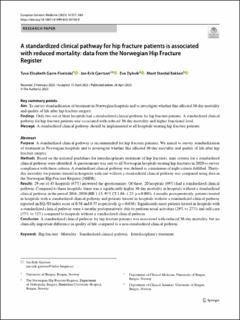| dc.contributor.author | Garre-Fivelsdal, Tuva Elisabeth | |
| dc.contributor.author | Gjertsen, Jan-Erik | |
| dc.contributor.author | Dybvik, Eva Hansen | |
| dc.contributor.author | Bakken, Marit Stordal | |
| dc.date.accessioned | 2023-11-02T09:24:29Z | |
| dc.date.available | 2023-11-02T09:24:29Z | |
| dc.date.created | 2023-06-27T11:03:51Z | |
| dc.date.issued | 2023 | |
| dc.identifier.issn | 1878-7649 | |
| dc.identifier.uri | https://hdl.handle.net/11250/3100187 | |
| dc.description.abstract | Purpose: A standardized clinical pathway is recommended for hip fracture patients. We aimed to survey standardization of treatment in Norwegian hospitals and to investigate whether this affected 30-day mortality and quality of life after hip fracture surgery.
Methods: Based on the national guidelines for interdisciplinary treatment of hip fractures, nine criteria for a standardized clinical pathway were identified. A questionnaire was sent to all Norwegian hospitals treating hip fractures in 2020 to survey compliance with these criteria. A standardized clinical pathway was defined as a minimum of eight criteria fulfilled. Thirty-day mortality for patients treated in hospitals with and without a standardized clinical pathway was compared using data in the Norwegian Hip Fracture Register (NHFR).
Results: 29 out of 43 hospitals (67%) answered the questionnaire. Of these, 20 hospitals (69%) had a standardized clinical pathway. Compared to these hospitals, there was a significantly higher 30-day mortality in hospitals without a standardized clinical pathway in the period 2016–2020 (HR 1.13, 95% CI 1.04–1.23; p = 0.005). 4 months postoperatively, patients treated in hospitals with a standardized clinical pathway and patients treated in hospitals without a standardized clinical pathway reported an EQ-5D index score of 0.58 and 0.57 respectively (p = 0.038). Significantly more patients treated in hospitals with a standardized clinical pathway were 4 months postoperatively able to perform usual activities (29% vs 27%) and self-care (55% vs 52%) compared to hospitals without a standardized clinical pathway.
Conclusion: A standardized clinical pathway for hip fracture patients was associated with reduced 30-day mortality, but no clinically important difference in quality of life compared to a non-standardized clinical pathway. | en_US |
| dc.language.iso | eng | en_US |
| dc.publisher | Springer | en_US |
| dc.rights | Navngivelse 4.0 Internasjonal | * |
| dc.rights.uri | http://creativecommons.org/licenses/by/4.0/deed.no | * |
| dc.title | A standardized clinical pathway for hip fracture patients is associated with reduced mortality: data from the Norwegian Hip Fracture Register | en_US |
| dc.type | Journal article | en_US |
| dc.type | Peer reviewed | en_US |
| dc.description.version | publishedVersion | en_US |
| dc.rights.holder | Copyright 2023 the authors | en_US |
| cristin.ispublished | true | |
| cristin.fulltext | original | |
| cristin.qualitycode | 1 | |
| dc.identifier.doi | 10.1007/s41999-023-00788-9 | |
| dc.identifier.cristin | 2158443 | |
| dc.source.journal | European Geriatric Medicine | en_US |
| dc.source.pagenumber | 557-564 | en_US |
| dc.identifier.citation | European Geriatric Medicine. 2023, 14, 557-564. | en_US |
| dc.source.volume | 14 | en_US |

